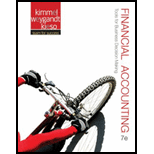
Concept explainers
(a)
Periodic Inventory System: It is a system in which the inventory is updated in the accounting records on a periodic basis such as at the end of each month, quarter or year. In other words, it is an accounting method which is used to determine the amount of inventory at the end of each accounting period.
FIFO: In First-in-First-Out method, items purchased initially are sold first. So, the value of the ending inventory consists the recent cost for the remaining unsold items.
LIFO: In Last-in-First-Out method, items purchased recently are sold first. So, the value of the ending inventory consists the initial cost for the remaining unsold items.
To compute: The ending inventory using FIFO.
(b)
To compute: The ending inventory using LIFO.
Want to see the full answer?
Check out a sample textbook solution
Chapter 6 Solutions
Financial Accounting
- What accounting principle requires using the same accounting methods and principles from one period to another?a) Materiality principleb) Consistency principlec) Matching principled) Revenue recognition principlearrow_forwardThe audited accounts of Lindsay Co. for year-end August 31, 2014 show a profit of $3,115,000 after charging the following: Depreciation 430,000 Rent 175,000Legal fees 1,350,000Audit fees 88,000 Donations 119,000Bad debts 242,000Foreign Travel 395,750Interest payments 62,375 Other Information: a. Legal fees are as follows: Expenses in respect of recovery of debts, $585,000 Expenses related to the increase private share capital, $765,000 b. Lindsay Co. donated $65,500 to UTECH University and $53,500 to HELP, a private charity registered under the Charities Act. c. Bad debts are as follows: • A loan of $76,130 to Derek Stan who failed to repayit. • $63,017, owed by Simplicity Ltd. which was declared bankrupt. • The balance is a percentage of receivables at year end which is deemed to be bad. d. Foreign travel expense included $268,210 for a vacation package for the marketing manager’s and his family plane tickets. The remaining…arrow_forwardWhat does the accounting equation (Assets = Liabilities + Equity) represent?a) The relationship between revenues and expensesb) The relationship between assets and liabilitiesc) The relationship between debits and creditsd) The relationship between resources and claims to those resourcesarrow_forward
- Which financial statement shows the inflows and outflows of cash during a specific period?a) Balance sheetb) Income statementc) Cash flow statementd) Statement of changes in equityarrow_forwardChoose the right optionarrow_forwardWhat does GAAP stand for in financial accounting?a) Generally Accepted Accounting Principlesb) Generally Applied Accounting Proceduresc) General Accounting and Auditing Practicesd) Generally Acknowledged Accounting Policiesarrow_forward
- Provide step by step explanation general accounting questionarrow_forwardWhat accounting principle requires using the same accounting methods and principles from one period to another?a) Materiality principleb) Consistency principlec) Matching principled) Revenue recognition principlearrow_forwardQ: The double-entry bookkeeping system ensures that:a) Revenues are recorded on the left side of the accounting equationb) Expenses are recorded on the right side of the accounting equationc) Assets always equal liabilitiesd) Every transaction is recorded with equal debits and creditsarrow_forward
- Answer? ? Financial accountingarrow_forward1.25.12-PacificCoast Hotel's laundry department uses load optimization tracking. Each washer has 25kg capacity. Today's loads averaged: Morning 22kg, Afternoon 19kg,Evening 23kg. What is the unutilized capacity percentage?arrow_forwardGeneral accountingarrow_forward

 AccountingAccountingISBN:9781337272094Author:WARREN, Carl S., Reeve, James M., Duchac, Jonathan E.Publisher:Cengage Learning,
AccountingAccountingISBN:9781337272094Author:WARREN, Carl S., Reeve, James M., Duchac, Jonathan E.Publisher:Cengage Learning, Accounting Information SystemsAccountingISBN:9781337619202Author:Hall, James A.Publisher:Cengage Learning,
Accounting Information SystemsAccountingISBN:9781337619202Author:Hall, James A.Publisher:Cengage Learning, Horngren's Cost Accounting: A Managerial Emphasis...AccountingISBN:9780134475585Author:Srikant M. Datar, Madhav V. RajanPublisher:PEARSON
Horngren's Cost Accounting: A Managerial Emphasis...AccountingISBN:9780134475585Author:Srikant M. Datar, Madhav V. RajanPublisher:PEARSON Intermediate AccountingAccountingISBN:9781259722660Author:J. David Spiceland, Mark W. Nelson, Wayne M ThomasPublisher:McGraw-Hill Education
Intermediate AccountingAccountingISBN:9781259722660Author:J. David Spiceland, Mark W. Nelson, Wayne M ThomasPublisher:McGraw-Hill Education Financial and Managerial AccountingAccountingISBN:9781259726705Author:John J Wild, Ken W. Shaw, Barbara Chiappetta Fundamental Accounting PrinciplesPublisher:McGraw-Hill Education
Financial and Managerial AccountingAccountingISBN:9781259726705Author:John J Wild, Ken W. Shaw, Barbara Chiappetta Fundamental Accounting PrinciplesPublisher:McGraw-Hill Education





